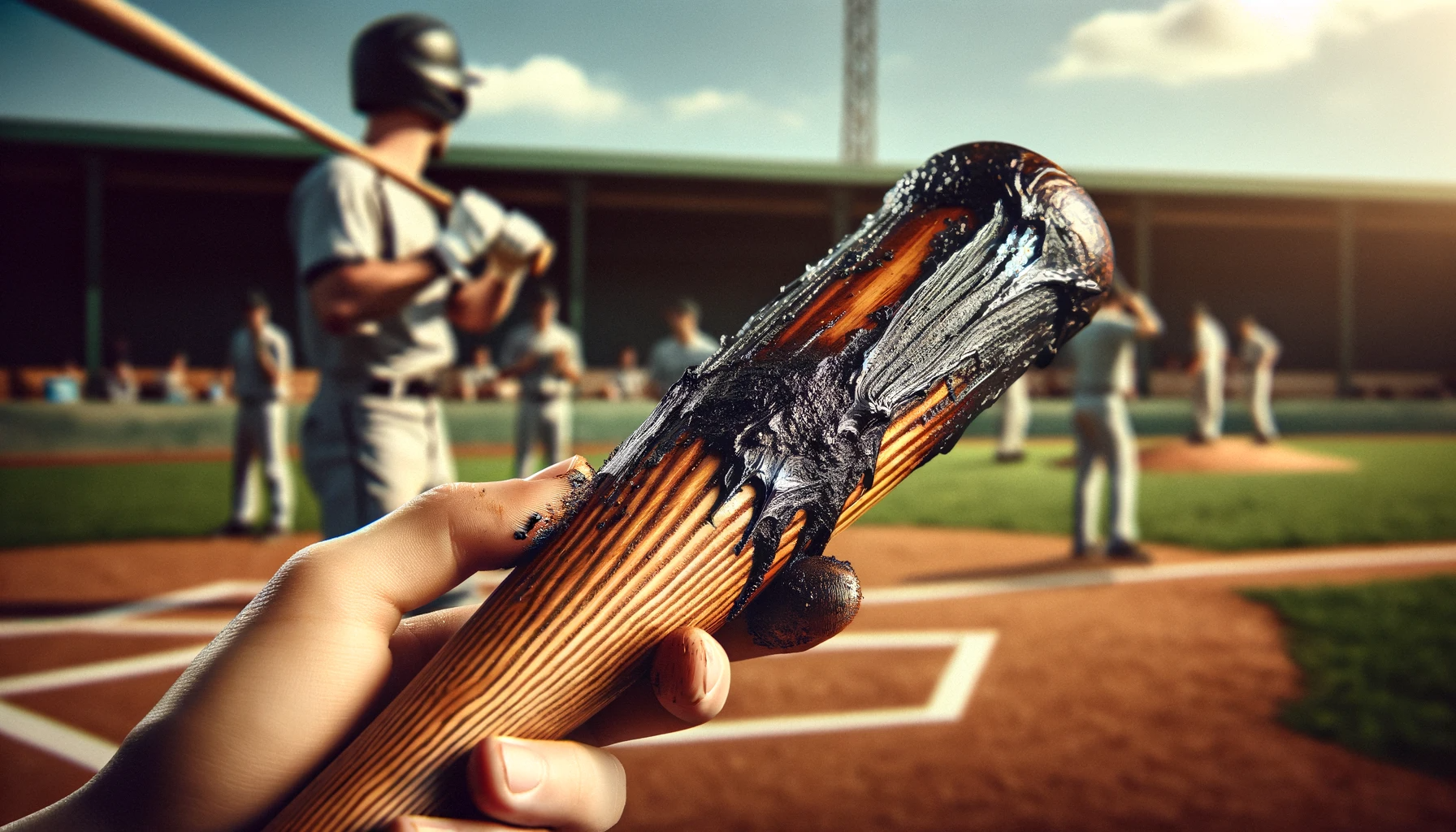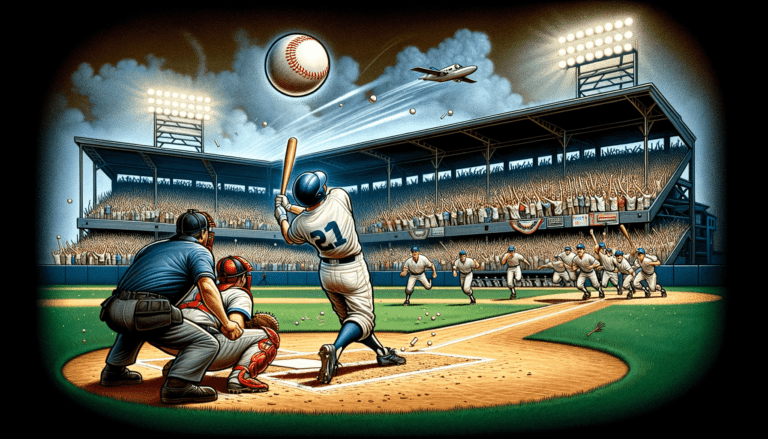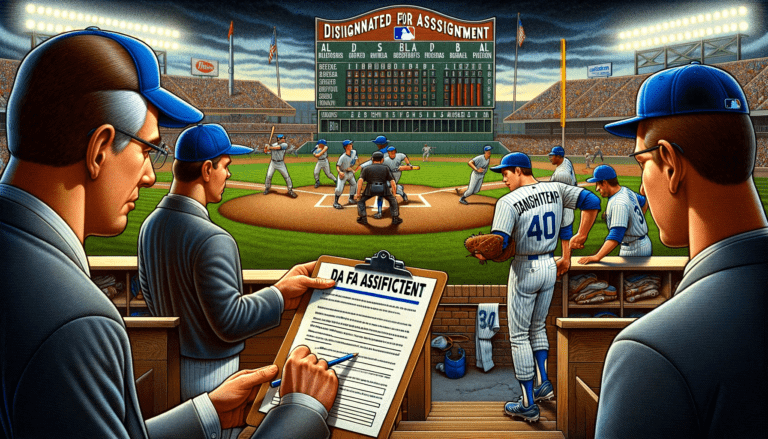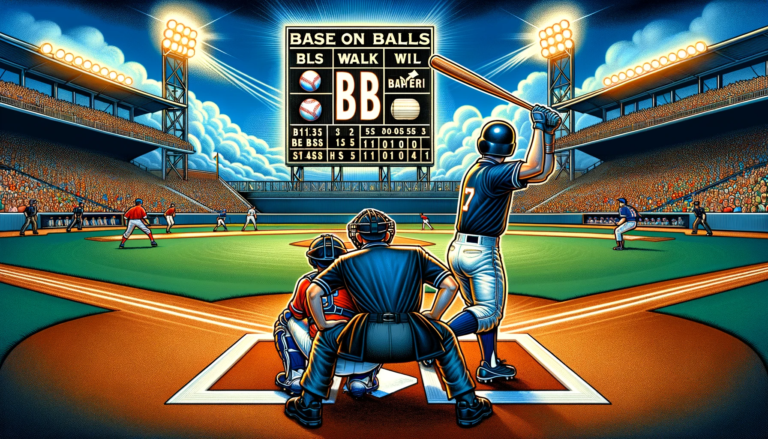What Does Pine Tar Do in Baseball Bat?
Pine tar is a sticky substance that baseball players apply to their bats. Its main purpose is to improve the grip on the bat. When a batter holds the bat tightly, the pine tar sticks and helps prevent the bat from slipping out of their hands during a swing.
This gives the batter more control and power when hitting the ball. Pine tar on wood bats also helps protect the bat from moisture and can extend its lifespan. However, there are rules about how much pine tar can be used on a bat to ensure fair play.
In this article, we’re going to explore the ins and outs of this sticky substance and its role in the game.
Whether you’re a seasoned player or just a curious fan, understanding the impact of the pine tar game can give you a deeper appreciation for the sport. You may read the guide on What Does a Bat Flip Mean in Baseball
Key Takeaways
- Pine tar is a grip-enhancing substance with a unique chemical composition that has been historically used in baseball to improve bat handling.
- Regulations exist to limit the application of pine tar on bats, ensuring fair play, but players have developed preferences and techniques within these rules.
- The use of pine tar has led to notable controversies, highlighting the fine line between gaining an edge and gaining an unfair advantage.
- Technological innovations are challenging the traditional use of pine tar, offering modern alternatives for bat grip enhancement.
- Pine tar has transcended its practical use, becoming a symbol of baseball culture, nostalgia, and identity in media and storytelling.
The Sticky Foundation: Understanding Pine Tar in Baseball
The Chemistry of Pine Tar and Its Grip-Enhancing Properties
Pine tar, a sticky substance derived from the distillation of pine wood, has been a staple in baseball for its ability to enhance grip on the bat.
Its natural tackiness allows players to hold their bats more securely, especially in hot or humid conditions where hands might otherwise slip.
The grip-enhancing properties of pine tar are attributed to its chemical composition, which includes a complex mixture of organic compounds such as resin acids and phenols.
These compounds are inherently sticky and provide friction between the bat and the player’s hands, resulting in improved control and power during the swing.
Players often apply pine tar to their bats in a careful process that involves:
- Heating the tar to make it more pliable
- Spreading a thin layer on the handle of the bat
- Allowing it to cool and set for optimal tackiness
Understanding the chemistry behind pine tar’s effectiveness is crucial for players looking to maximize their performance at the plate.
Historical Use of Pine Tar in Baseball
The sticky substance known as pine tar has been a staple in baseball for decades, enhancing the grip on wooden bats and becoming an integral part of the sport’s history.
Its use dates back to the early days of baseball when players sought any advantage to improve their control and performance at the plate.
- Pine tar’s primary function is to provide a tacky surface on the handle of the bat, allowing for a firmer grip and greater control when swinging.
- Over time, the application of pine tar became a ritual for many players, with some even developing their own unique methods of applying the substance.
While pine tar’s role in baseball is largely functional, it has also been at the center of controversy.
One of the most famous incidents involved George Brett’s pine tar home run against the Yankees, where the bat was removed from the game due to excessive pine tar application.
This event highlighted the need for clear regulations regarding the use of pine tar in the sport. You may read also How to Tell If a Baseball Bat is Dead
Regulations and Limits on Pine Tar Application
The application of pine tar in baseball is not without its rules and boundaries. Major League Baseball (MLB) has established clear regulations to ensure the substance is used fairly and within the spirit of the game.
Players are allowed to apply pine tar only to the handle of the bat, up to a maximum of 18 inches from the base.
This limit is designed to prevent the tar from making contact with the ball, which could affect its trajectory and the outcome of the play.
Umpires are tasked with enforcing these regulations during games. They have the authority to inspect bats and can remove any that do not comply with the rules.
The consequences for using an illegal bat can be severe, including ejections from the game and potential suspensions.
To avoid penalties, players and equipment managers must adhere to the following guidelines:
- Ensure pine tar is applied within the 18-inch limit.
- Regularly check bats for compliance before and during games.
- Be prepared for umpire inspections at any point.
These measures are in place to maintain the integrity of baseball and uphold a level playing field for all competitors.
Read Also: What Does Drop 8 Mean in Baseball Bats
The Player’s Perspective: How Pine Tar Affects Performance
Grip and Control: The Player’s Experience
For baseball players, the feel of the bat in their hands is crucial. The application of pine tar to the handle is a time-honored method to enhance grip and control.
This sticky substance allows for a firmer hold, reducing the chances of the bat slipping during a critical swing.
- Players often apply pine tar up to the maximum allowable length on the bat handle.
- The amount and pattern of application can vary greatly among players, with some preferring a light coating while others lay it on thick.
- The weather can also influence the use of pine tar; on hot and humid days, players might apply more to counteract the additional sweat.
The tactile connection between a batter and their bat is a subtle yet vital aspect of the game.
Pine tar’s legality for batters, as opposed to pitchers, underscores its accepted role in enhancing this connection.
However, the ethical use of pine tar remains a point of discussion, as it is disallowed on the mound, highlighting the fine balance between utility and fair play.
Pine Tar in Practice: Techniques and Player Preferences
The application of pine tar to baseball bats is a time-honored tradition, with each player often developing their own unique method.
The sticky substance not only enhances grip but also allows players to relax their hands, reducing the likelihood of muscle tension and improving swing mechanics.
Players typically apply pine tar to the handle of the bat, but the extent and pattern of application can vary widely. Some prefer a light coating, while others may layer it thickly for a more substantial feel.
Here are a few common techniques observed in the game:
- A basic swipe up the handle for minimal coverage
- Concentric circles for a textured grip
- Custom patterns that cater to individual hand placement
Preferences also extend to the type of liquid pine tar being used, with variations in stickiness and texture influencing a player’s choice.
Ultimately, the goal is to achieve a level of comfort and control that complements their batting style.
The Psychological Edge: Confidence at the Plate
The application of pine tar to a baseball bat is not just a physical aid but also a psychological booster.
Players often report a heightened sense of confidence when they step up to the plate and hit with a bat that has just the right amount of stickiness.
This assurance is crucial, especially in high-pressure situations where every swing counts.
- The tactile feedback from a pine-tar-enhanced grip allows for a firmer hold, reducing the fear of a bat slipping.
- A consistent grip can lead to a more controlled and powerful swing.
- The ritual of applying pine tar itself can serve as a mental cue, preparing a player for the task at hand.
In essence, the use of pine tar becomes a part of a player’s pre-at-bat routine, reinforcing their readiness to face the pitcher.
The best bat pine tar, as some might say, makes batting gloves sticky again, providing that extra assurance that can make all the difference in a game-defining moment.
Read Also: Why Do Baseball Players Use Wooden Bats
Controversies and Scandals: Pine Tar Beyond the Rules
Famous Pine Tar Incidents in Baseball History
One of the most notorious events in baseball history is the Pine Tar Incident of 1983, which involved the Kansas City Royals and the New York Yankees.
The controversy centered around the amount of pine tar on George Brett’s bat, which exceeded the regulations set by the league.
- The umpires initially called Brett out, negating his go-ahead home run.
- The decision was later overturned, and the game was completed under protest, with the Royals ultimately winning.
This incident not only sparked debates about the rules governing pine tar use but also highlighted the significant impact that equipment regulations can have on the outcome of a game.
It remains a pivotal example of how a seemingly minor infraction can escalate into a major dispute, forever etched in the annals of baseball lore. You may read also What Does Bpf Mean on a Baseball Bat
The Fine Line: When Use Becomes Abuse
The application of pine tar on baseball bats is a practice steeped in tradition, yet it treads a delicate line between acceptable use and outright abuse.
The essence of the controversy lies in the amount applied and the location on the bat.
Players and coaches are well aware of the rules, which stipulate that pine tar may not extend beyond 18 inches from the base of the bat.
- The purpose of pine tar is to enhance grip, but when applied excessively, it can also affect the flight of the ball, giving the batter an unfair advantage.
- Umpires are tasked with the challenging job of policing this rule, often leading to disputes and interruptions during the game.
- The infamous ‘Pine Tar Incident’ involving George Brett in 1983 is a prime example of how a seemingly minor infraction can escalate into a major controversy.
The debate continues as to where to draw the line. While some argue for a strict interpretation of the rules, others advocate for a more lenient approach, emphasizing the importance of tradition and player preference in the game.
The ongoing discussion reflects the complex nature of maintaining the integrity of baseball while respecting its storied past.
The Ongoing Debate: Fair Play vs. Unfair Advantage
The debate over the use of pine tar in baseball is a microcosm of the larger conversation about fairness and competitive advantage in sports.
Is it a simple matter of maintaining a grip, or does it cross the line into the realm of performance enhancement?
- The rules regarding pine tar are clear, yet their enforcement can be inconsistent, leading to confusion and controversy.
- Players and coaches often walk a fine line, balancing the need for control with the respect for the game’s integrity.
- Fans and analysts alike scrutinize the use of pine tar, questioning whether it unfairly skews the playing field.
As baseball continues to evolve with the adoption of advanced analytics and the rise of dual-threat players, the conversation around pine tar remains a sticky subject.
The unwritten rules of the game are often as influential as the official ones, and the distinction between an accepted practice and an unfair advantage is frequently debated.
Read Also: How to Hold a Baseball Bat Right Handed
Conclusion
In conclusion, pine tar serves as a crucial element in enhancing grip and control for baseball players.
Its sticky nature allows batters to maintain a firm hold on the bat, which can make all the difference in their performance at the plate.
By understanding the role of pine tar in baseball bats, players can optimize their game and fans can appreciate the intricacies of the sport even more.
So next time you see a player applying too much pine tar to their bat, you’ll know exactly why it’s an essential part of the game.
Frequently Asked Questions
What does pine tar do on a baseball bat?
Pine tar is a foreign substance used on baseball bats to enhance the grip of hitters, allowing them better control and handling of the bat during their swing. This sticky substance helps prevent the bat from slipping out of their hands, especially in hot and humid conditions.
Is pine tar legal for use in baseball?
Yes, pine tar is legal in baseball but with certain restrictions. Players can apply pine tar only on the handle and up to a certain length of the bat, typically no more than 18 inches from the knob, to prevent it from affecting the ball.
How has pine tar use in baseball evolved over time?
Pine tar has been used for decades in baseball to improve bat grip. Over time, regulations have been implemented to control its use, and there have been notable controversies when players have used it excessively or inappropriately.
Can pitchers use pine tar in baseball?
No, pitchers are not allowed to use pine tar in baseball as it can alter the flight of the ball and give them an unfair advantage. If a pitcher is caught using pine tar, they can be ejected from the game and face further penalties.
What are some alternatives to pine tar for improving bat grip?
Alternatives to pine tar include grip sticks, batting gloves, and various resin or rosin-based products. Manufacturers also produce synthetic adhesives and tacky sprays designed to enhance grip without the messiness of a pine tar stick.
How do advancements in technology affect the use of pine tar in baseball?
Technological advancements have led to the development of new grip-enhancing products that can serve as substitutes for pine tar. These innovations offer players different options for maintaining bat grip while potentially reducing the need for traditional pine tar.







